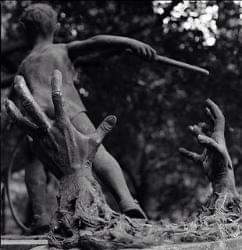These Polish women led into the woods by German Ordnungspolizei won’t be coming back.
The one in the foreground, wearing white, patterned coat, is Janina Skalska, Polish Red Cross worker. She's 39, the date is 21 June 1940, the coat is similar to the one in the pre-war photograph, but if you could see her face, the expression would be entirely different.
The AB Aktion was a German plan to decapitate the Polish nation – and Palmiry, a village near Warsaw, became one of the blocks for the axe. It is in its woods that between December 1939 and July 1941 at least 2,000 prominent Poles were brutally murdered.
It usually happened in the mornings: the pits, dug by Hitlerjugend and Baudienst youth the day before, were waiting for the people from Pawiak and other prisons. Blindfolded victims were lined up on the longer side, and the execution squad shot them into the gaping graves.
There must have been crying, prayers and begging – but they counted for nothing and changed nothing. As far as the Germans were concerned, these Poles belonged under the ground, so as soon as they got there, the ground was levelled and pine trees planted.
19 months of slaughter claimed the lives of society leaders – lawyers, doctors, teachers, statesmen, sportsmen and artists – but also resistance members and random people. On 20 and 21 June, over 350 of them died, and the Hitlerjugend had had to dig larger pits than usual.
However, Poland wouldn’t let anyone massacre her elites and get away with it. Since these women led into the woods never came back, and since the Germans thought that Poles belonged under the ground, the Poles went underground, and fought back.
But before that happened, Janina Skalska, held firmly by a German policeman, was taken into the woods to a waiting pit. Post-war exhumation revealed that this particular grave contained only female bodies, with one exception: Janina’s brother Eugeniusz.
One womb, one tomb.












Comments
Post a Comment